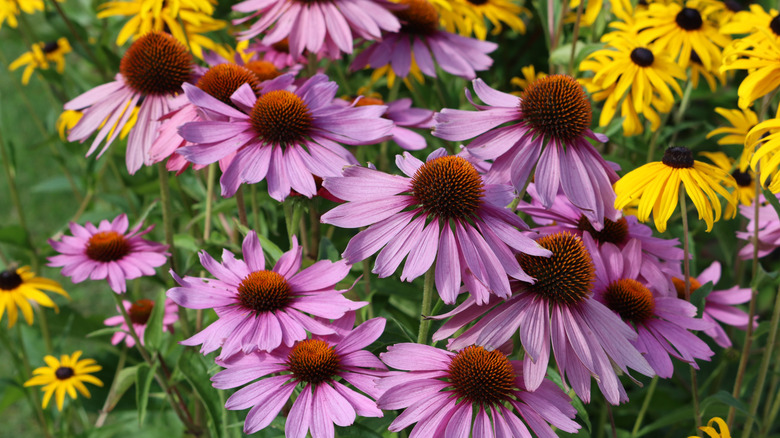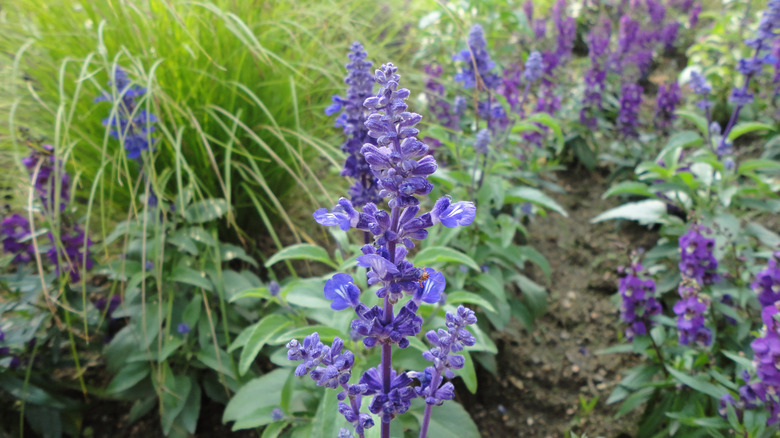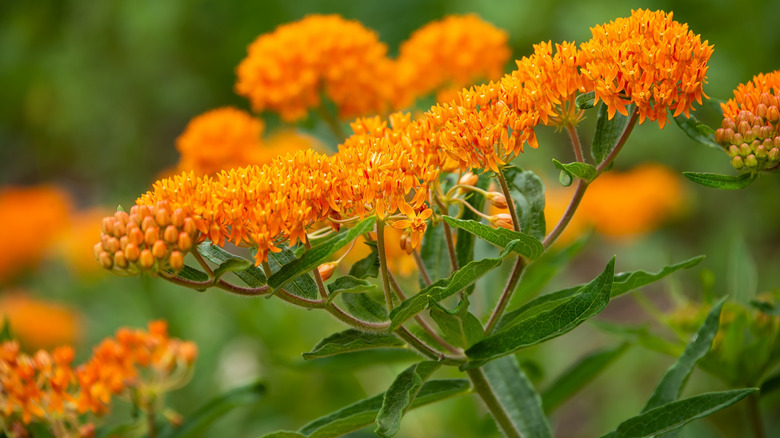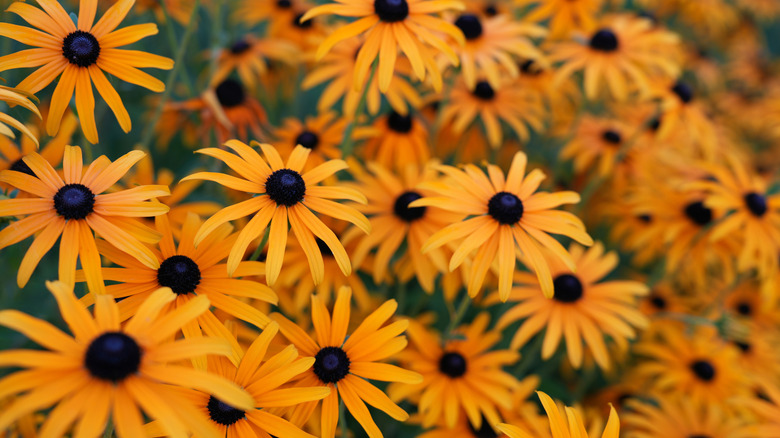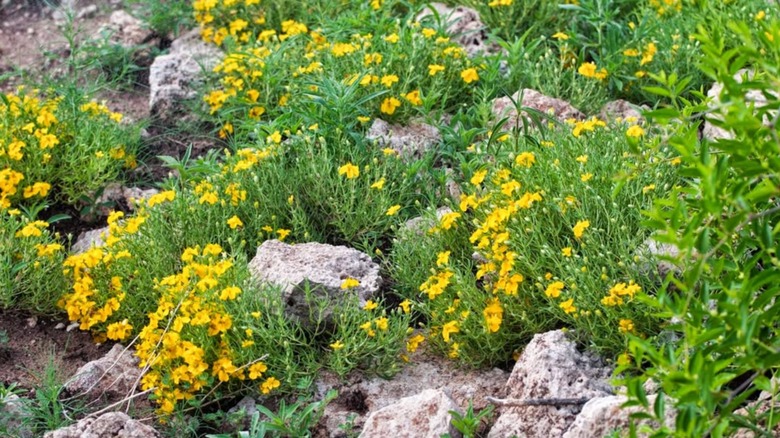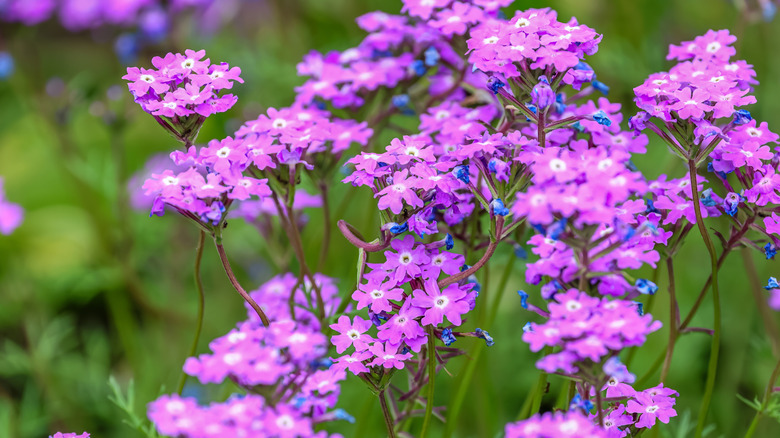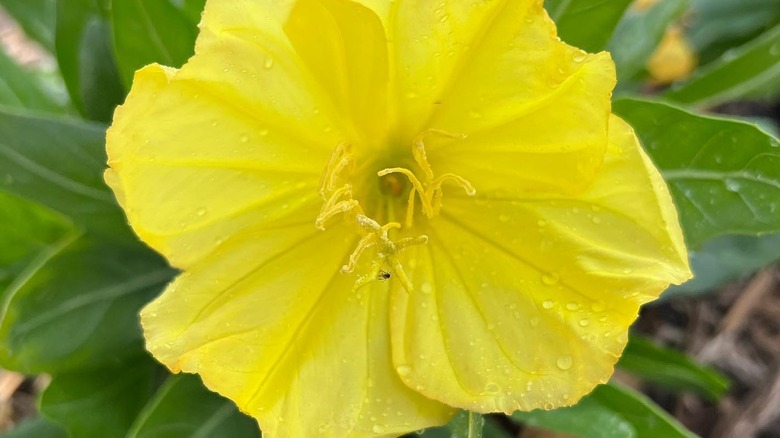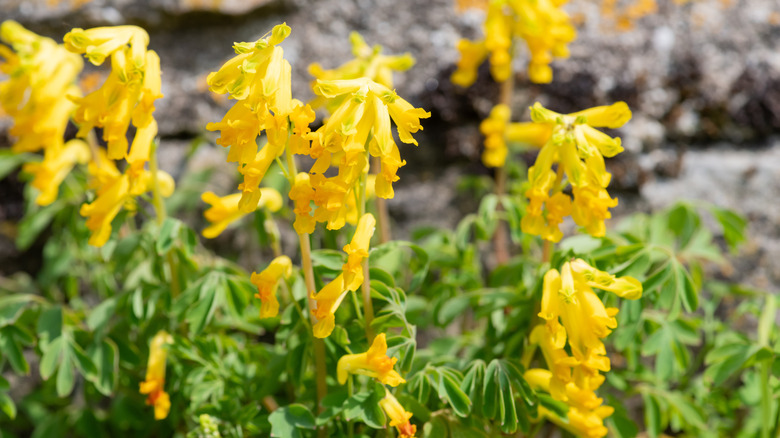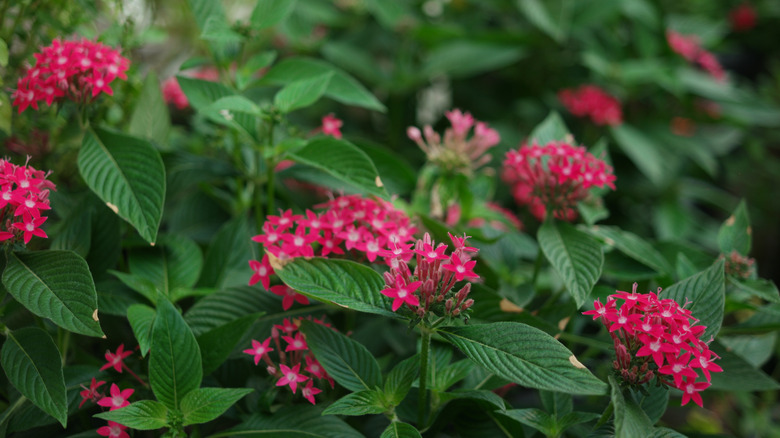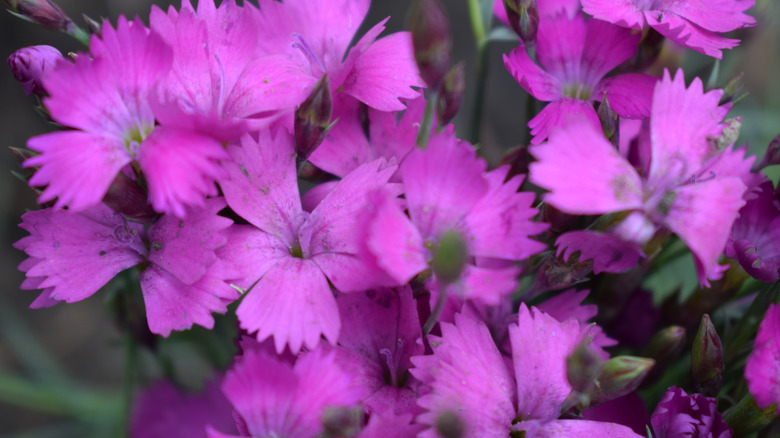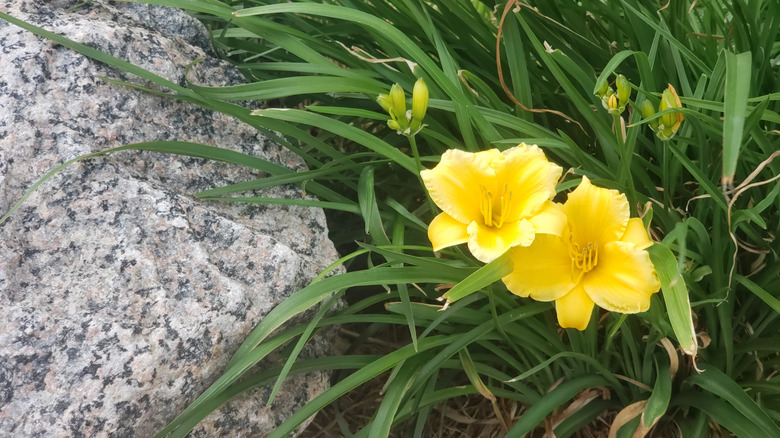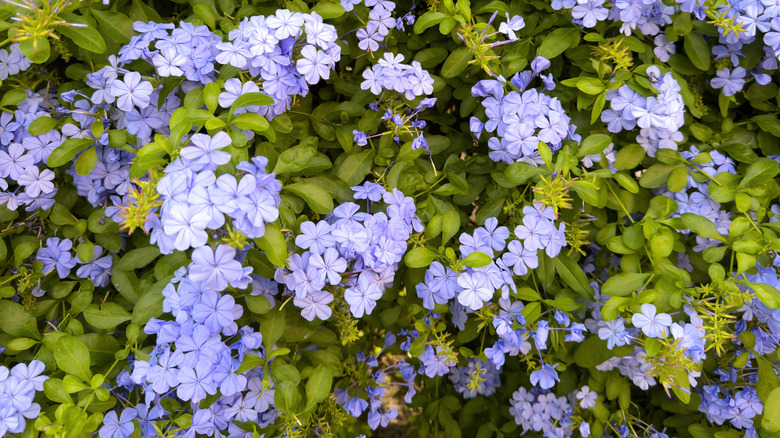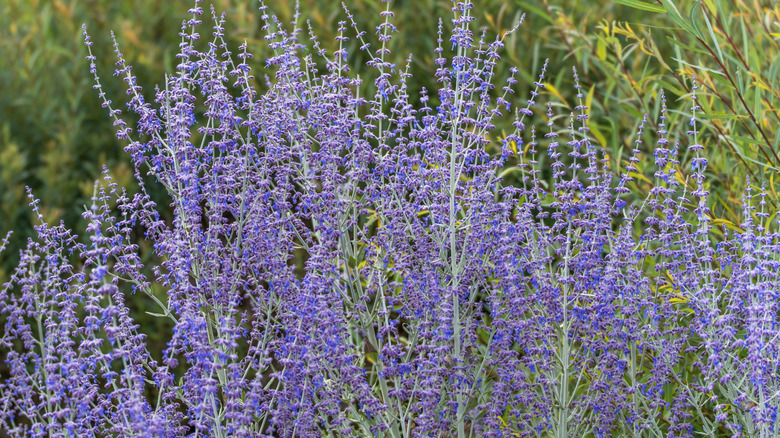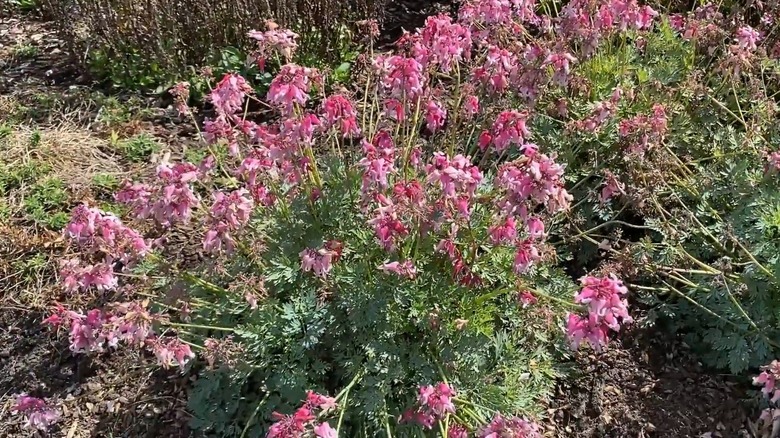Forget Coneflowers: These 27 Flowers Add Variety To Your Garden
It wouldn't be a stretch to say that if a garden can support coneflowers (Echinacea spp.), they're one of the top choices for planting. Rows of nodding, prickly brown heads surrounded by purple, pink, or yellow petals truly create a breathtaking sight. Being able to enjoy this view for a long time, from mid-summer until frost in most cases, is the cherry on top. However, to maintain a colorful display throughout the growing season, you don't have to rely solely on coneflowers. Many others, such as blanket flowers, black-eyed Susans, anise hyssops, and winecups, to name a few, also have long blooming periods.
Better yet, you can filter them further on desired attributes. For instance, if you like coneflowers for being native to the U.S., the top 13 plants (right up to yellow corydalis) share similar origins, while the rest are well-behaved non-natives. If deer seem to leave coneflowers alone in your garden, you might have similar luck with 'Apricot Sunrise' hyssop, rose verbena, and yarrow. Where dry spells are a concern, blue sage, plains zinnia, and daylilies might be helpful.
That being said, like coneflowers, their substitutes mentioned below also thrive in well-draining soils with full-to-part sun exposure. While they don't all thrive in USDA Hardiness Zones 3 through 9, their adaptive ranges fall within these brackets. Ready to move beyond coneflowers this growing season? Here are 27 flowers you can use in their stead for more variety.
'Apricot Sunrise' giant hyssop
'Apricot Sunrise' giant hyssop (Agastache 'Apricot Sunrise') is a lovechild of hummingbird mints native to the southwest U.S., but surpasses them in performance. Their apricot-orange flowers are quite showy and attract pollinators like hummingbirds, butterflies, and bees in droves from June through September. In milder climates, they may flower until the frost hits. Perennials in zones 6 through 9, they're grown as annuals elsewhere. Pop them in sunny sites bordering the patio, or the favored entry points for deer, to discourage them. You may also snip the blooms for indoor arrangements.
Anise hyssop
Use anise hyssop (Agastache foeniculum) to add vertical interest to your garden. In bloom, this showy perennial stands nearly 5 feet high, sporting bluish-purple flower spikes, which, depending on the location, first appear in June or July and last through late fall. Keep removing discolored flowers throughout the growing season for reblooms, but leave a few aside for seed production in the fall. Anise hyssop is mighty popular with hummingbirds and butterflies, but not so much with deer and rabbits, who dislike its licorice-smelling foliage. You may grow these long-blooming native plants in zones 4 through 8.
Blanket flower
Blanket flowers (Gaillardia spp.) were named because the vividly-colored patterns of their flowers are surprisingly similar to the designs of Native Americans' blankets. Throughout the summer and autumn, their daisy-esque blooms will draw in butterflies and bees in droves to your garden. Retain the spent blooms so they may make way for seeds for goldfinches. While this act may shorten the plant's life, blanket flower self-sows in sufficient numbers for a reliable return. They require fast-draining soils to overwinter successfully, though pruning these perennials in summer down to 6 inches is equally useful. Hardiness levels vary across varieties.
Blue sage
Blue sage (Salvia azurea) is a showy wildflower endemic to the central and southern U.S. states. In sunny sites, it produces sprays of azure blue blooms, around which butterflies gather from July through October. Sadly, it can become floppy during the flowering season if you fail to cut back its foliage in spring or grow it in heavily-fertilized soils. Since native bees like to overwinter in their stems, delay the cleanup until spring. Blue sage's tolerance for drought and dry conditions makes it ideal for rock gardens located in zones 5 through 9.
Butterfly weed
Native to the southern and eastern U.S., butterfly weed (Asclepias tuberosa) is a long-blooming perennial that's adorned with clusters of yellowish-orange flowers from May through August. Regular deadheading encourages re-blooming and keeps its self-seeding habit in check. Beloved by monarch butterflies and various moth species, butterfly weed deserves a spot in any pollinator garden — whether planted en masse or paired with purple coneflowers (if you can't quite forget them). Just be sure to keep these plantings away from pets, as they're mildly toxic, and wear gloves when handling them. They're hardy in zones 3 to 9.
'Concord Grape' spiderwort
A hybrid of common and Ohio spiderworts, which are native to the east U.S., 'Concord Grape' (Tradescantia x andersoniana 'Concord Grape') is a low-growing perennial, hardy in zones 4 through 7. You'll like it for its yellow-stamened, deep purple flowers that put on a spectacular display from May through August when deadheaded regularly. While the iris-like foliage is pretty, it can grow straggly in peak summers, so trim the foliage to the ground level to restore vigor. You can define paths or plant it in beds to attract honeybees.
Orange coneflower
Orange coneflower or Black-eyed Susan (Rudbeckia fulgida) is a low-maintenance perennial plant that hardly needs any attention to thrive in zones 3 to 9. Given full sun exposure and good drainage, it'll reward you with brown-eyed, orange blooms throughout the summer and fall. Toward the end of the flowering season, allow it to form seedheads for birds. Their foliage may appear slightlu tattered when the larvae of checkerspot and wavy-lined emerald butterflies are actively feeding. Orange coneflowers are great in urban settings, as they can tolerate pollution and drought, as well as in suburban gardens disturbed by deer.
Oxeye sunflower
Hailing from eastern and north-central U.S., oxeye sunflower (Heliopsis helianthoides) is an easy-to-grow perennial for zones 3 to 9. Golden-eyed, orange-rayed blooms appear in June, to the utter delight of onlookers and pollinators. With diligent deadheading, their sunny show lasts well into September. Oxeye sunflowers can reach nearly 6 feet and may require staking. Mass plant them in perennial borders to dissuade deer and rabbits from entering, or use them as accents in water-wise landscapes. Oxeye sunflowers adapt to most substrates, including heavy clay or infertile soils.
Plains zinnia
If you're trying to lower your water bills by switching over to a xeric landscape, plant it with plains zinnia (Zinnia grandiflora), also known as Rocky Mountain zinnia. This southwest U.S. native wildflower thrives in dry, hot sites with lean, rocky soils. Due to such attributes, it can also be used to define driveways that become too hot in the summer due to the urban heat island effect. Plains zinnias spread via rhizomes and may be used to check erosion on sloped yards. Their papery, yellow blooms are visible from May through October in zones 4 to 8.
Rose verbena
Native to North America, rose verbena (Verbena canadensis) is a fast-growing perennial you may mass in sunny borders or group as a flowering groundcover. Through constant snipping off dead blooms, you can encourage this plant to produce pinkish-purple flowers from spring through frost and also feed the famished hummingbirds and butterflies. Perennial in zones 6 to 10, rose verbena is grown as an annual elsewhere. It exhibits tolerance for heat, drought, humidity, and salt drift, but will not handle deer pressure.
'Silver Blade' evening primrose
Native to the Great Plains region, 'Silver Blade' evening primrose (Oenothera macrocarpa subsp. incana 'Silver Blade') is a gorgeous perennial that's sure to bring color to the garden. From May through frost, this silver-leaved plant is covered in yellow, cup-shaped blooms that bees love. It has minimal water needs and high tolerance for drought, making it a great fit for dry landscapes. To keep it vigorous, prune the plant to ground level every spring. It is adaptable in zones 4 to 9. Although short, it can extend 2 feet wide and more if allowed to self-sow.
Winecup
Winecup or purple poppy mallow (Callirhoe involucrata) is a drought-tolerant wildflower you can let loose in dry, hot patches for a lovely groundcover. Regular pinching of the stem tips encourages continuous waves of magenta blooms from late spring until the first hard frost. Though perennials in zones 4 through 8, their foliage deteriorates past summer. To keep the plants vigorous, cut back their foliage every spring. While adaptive to most soils, winecups require excellent drainage, especially in areas experiencing winter rains, to prevent them from becoming sparse and gangly.
Yarrow
For those who maintain a cottage garden, yarrow (Achillea millefolium) could be the key to quickly covering the area, thanks to its self-seeding capability. In formal beds, promptly remove the spent flowers for containment or use a better-behaved cultivar — here are 14 yarrow varieties that add stunning perennial color to get you started. Yarrows bloom profusely in the summer and fall, easily coming to the notice of bees and butterflies. They are tolerant of heat, drought, salt, and deer, making them highly versatile plantings for zones 3 through 9. They aren't, however, pet-friendly and can cause contact dermatitis.
Yellow corydalis
In partially shaded areas or underneath tall shrubs, give yellow corydalis (Corydalis lutea) a go. Starting from spring until it's frost-killed, this European import is covered in bright yellow blooms, offering several months of color. But it may take over the beds if allowed to set seed, especially in gravelly soils — thankfully, errant seedlings are easily yanked out. Given the complex requirements to start seeds, yellow corydalis are ideally grown using nursery starts. They enjoy organically rich, well-draining soils in zones 4 through 8.
'Butterfly Blue' pincushion flower
Hardy in zones 5 through 9, 'Butterfly Blue' pincushion flower (Scabiosa columbaria 'Butterfly Blue') is a compact plant with a surprisingly long-lasting display. Starting in April, its ferny foliage is decked in lavender-blue flowers and remains so through frost. In southern areas with mild weather, you may enjoy the blooms year-round with diligent deadheading. 'Butterfly Blue' requires well-draining, alkaline soils and doesn't perform well in winter rains. Mass plant in beds and borders to lure in butterflies and hummingbirds. To a limited extent, it can tolerate drought and deer.
'Blue Star' kalmeris
'Blue Star' kalmeris (Kalimeris incisa 'Blue Star') has an aster-like appearance when its yellow-eyed, blue-rayed flowers are on display in summer. Shearing the foliage after the first wave will stimulate re-blooming in the fall, keeping the local bees and butterflies fed. 'Blue Star' grows about 1 ½ feet tall and wide, and so should be massed to create a sizable impact. It's unfussy about pH levels and tolerates hot, humid sites prone to occasional drought spells. Deer and rabbits show little interest in consuming their foliage. 'Blue Star' must be divided every few years to avoid spreading.
'Blue Wonder' nepeta
'Blue Wonder' nepeta (Nepeta racemosa 'Blue Wonder') is truly a wonder in bloom. It flowers for an exceptionally long time — May through September (sometimes October) — showing off deep blue petals against gray-green leaves. But you must remove the discolored flowers for re-blooming. It tops out at 1 foot, and can be utilized as a pollinator-friendly, deer-resistant ground cover in average garden soils and borders. Its drought tolerance also makes it appropriate for dry sites. 'Blue Wonder' won't self-seed and must be divided for new plants. It offers perennial color in zones 3 through 8.
'Bristol Fairy' baby's breath
'Bristol Fairy' baby's breath (Gypsophila paniculata 'Bristol Fairy') is a worthy addition in perennial beds left sparse after the spring bulbs and ephemerals went dormant. From April through August, its feathery foliage is sprinkled with double white blooms, providing lots of color and textural contrast. You'll have to crop the plant to ground level for re-blooms in the fall since deer aren't up to the task (which, ideally, is an advantage in suburban lots). Unfortunately, baby's breath is invasive in some U.S. states, including California, so check your local regulations before planting.
'Cat's Pajamas' catmint
'Cat's Pajamas' catmint (Nepeta 'Cat's Pajamas') flowers nearly three weeks ahead of its brethren in spring. By cutting back its foliage after the first flush fades in summer, you can enjoy reblooms, albeit not as profuse, in early fall. Another reason to get 'Cat's Pajamas' over other catmint varieties is that it's literally cloaked in lavender-blue flowers from the base to the tips, appearing like a cute, aromatic clump out to catch all the neighborhood's cats. Deer and rabbits will give this perennial a miss, but the bees and butterflies won't. Grow it in zones 3 to 8.
'Double Play Doozie' spirea
Double Play Doozie spirea (Spiraea hybrid) makes a loud statement with deep red foliage that emerges in early spring. This statement grows only louder in the growing season, when the purple-red blooms arrive in late spring and continue to bloom nonstop until frost. The best part, though? You don't have to deadhead the plant for re-blooms, as it doesn't produce any seeds! Unlike the standard spireas, it's unlikely to escape into the wild and spread. It grows about 3 feet high and wide, and may be used as a deer-resistant hedge in zones 3 through 8.
Firewitch dianthus
Firewitch dianthus (Dianthus gratianopolitanus 'Firewitch') is a deer-resistant plant you can grow in front of borders for deterrence. When deadheaded regularly, its compact clump features wisps of fringed, magenta petals, from late spring through early fall, while suffusing the air with a clove-like aroma. When not in bloom, the silvery-blue foliage mats out as an attractive groundcover. Firewitch dianthus can handle heat and be planted in dry, sunny sites. However, without supplemental irrigation during dry periods, it may not flower as profusely. It remains evergreen in the warmer ranges of zones 3 through 8.
'Happy Returns' daylily
When a plant is christened the "perfect perennial," you must take notice. 'Happy Returns' daylily (Hemerocallis 'Happy Returns') produces flower stalks of lemony yellow blooms in June and doesn't stop until the frost hits. In this duration, it stands tall — or as tall as its genetics allow, which isn't much at 2 feet — against grueling heat, sordid drought, and abject neglect. Besides the perennial corner, you can pop it in shrub borders and container gardens, provided you can keep your cute felines off these plants. They're at home in zones 3 to 9.
Plumbago
Plumbago (Ceratostigma plumbaginoides) is a beautiful ground cover you can plant to help choke out unwanted weeds or control soil erosion in sloped yards. Azure-blue flowers offer a stunning contrast against the reddish-bronze leaves from July through September, catching the attention of gardeners and pollinators alike. Though hardy in zones 5 through 9, it defoliates in the winter. So, mulch the roots in the cold months to ensure return come spring. Deer usually leave plumbago untouched, so you may utilize it in borders for some protection, but monitor its growth for any unwanted spread.
Russian sage
To attract structure to your perennial beds, grow Russian sage (Salvia yangii). By maturity, it stands about 4 feet tall and similarly wide. In June, it sprouts sprigs of lavender-blue inflorescences, with the show carried on into October. Pairing it with yellow-blooming rudbeckias, daylilies, or sunflowers can enhance the visual interest further. As it tolerates salt drift, you may plant Russian sage along the walkways. That way, you can also enjoy the pleasant aroma emitted from the leaves. Russian sage is perennial in zones 5 through 9 and tolerates poor soils.
'Steady as She Goes' gardenia
'Steady as She Goes' gardenia (Gardenia jasminoides 'Steady as She Goes') is a beautiful variety of gardenia that can tolerate summer heat and winter frost in zones 7 through 10. With evergreen foliage for foil, the white blooms offer a beautiful contrast as they unfurl from spring through fall, staying put even in the dreariest summers. Plant them along the walkways or borders to breathe in their pleasant fragrance without laying a welcome mat for deer. They grow wider than tall at about 4 feet and require excellent drainage for flowering.
'Stella D'Oro' daylily
Their individual blooms may only last a day, yet 'Stella D'Oro' daylilies (Hemerocallis 'Stella de Oro') put on a long-lasting display, carpeting the ground in a flash of yellow from spring through frost. As they tolerate most soils, humidity, and heat, they're easily grown in most gardens. However, supplemental watering is appreciated during extended dry spells for lush foliage. Being hybrids, Stella D'Oro daylilies will not clone their parent if grown from seed, and clumps must be separated every four years for more plants. They overwinter magnificently in zones 3 through 10, and can attract butterflies.
Sun Jewels 'Pink Diamonds' fern-leaved bleeding heart
Unlike typical bleeding hearts that crave shade, Sun Jewels 'Pink Diamonds' fern-leaved bleeding heart (Dicentra 'Pink Diamonds') is a sun-lover. It thrives in well-draining soils with full to part sun exposure in zones 3 through 9. In late spring, it unfurls pink petals with a two-toned effect, attracting pollinators. This display lasts through fall, but even outside of the bloom season, this perennial will continue to offer visual interest with its fern-like leaves. It tops out at 16 inches and can be located in border fronts; don't worry, deer will leave it alone.
